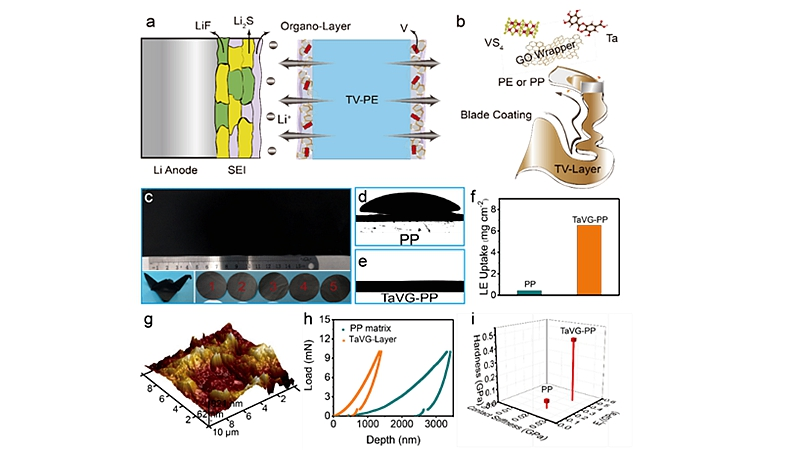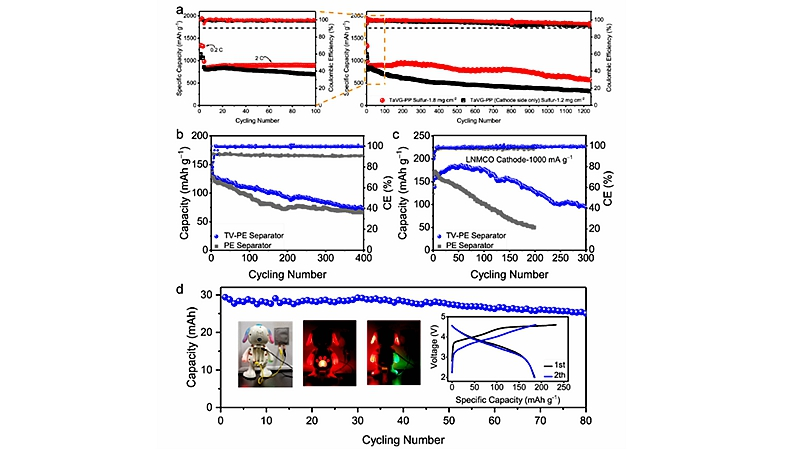In view of the problems with the existing lithium metal batteries, the research group of Professor Xu Chaohe from the School of Aerospace Engineering and Professor Wang Ronghua from the School of Materials Science and Engineering have recently designed and developed a functionalized polymer-matrix composite diaphragm. The composite membrane effectively regulates the deposition/dissolution behavior of lithium ions and catalyzes the conversion reaction of polysulfides, and by this way realizes the stable circulation of metal lithium cathode and lithium sulfur battery. The composite diaphragm developed by the research group has characteristics including ultra-thinness, light weight, polyfunctionality and high-temperature resistance, and can be hopefully applied in metal lithium batteries. The research findings have been recently published in Nano Energy (Nano Energy, 2022, 95, 106982) and Advanced Science (Advanced Science, 2022, 2102215), and the research group has submitted applications for a number of national patents. The first author of the paper is Zhao Qiannan, a postgraduate student of the School of Aerospace Engineering.
Lithium metal is believed to be an ideal cathode material for the next-generation high energy density battery devices. In the "14th Five-year Plan" of China, it was proposed to develop a subversive battery technology with an energy density of 600 Wh/kg based on lithium metal anode. However, to achieve the strategic development goal, the existing lithium cathode is facing a number of challenges, in particular the performance attenuation, short circuit and even thermal runaway caused by the formation of lithium dendrite and "dead lithium". For battery systems, high-specific-energy lithium sulfur battery is one of the important system options of high-energy chemical power supply in the future. However, in addition to the common challenges of the lithium cathode side, the sulfur anode side is also facing a number of complicated problems such as slow reaction kinetics, polysulfide shuttle and loss of active sulfur. As such, tackling these challenges with simple and practical solutions for good all has become the frontier topic and key core technology of development of high-performance metal lithium batteries with metal lithium as cathode.

Diaphragm is a bridge that connects the cathode and anode of secondary battery, and is one of the most important battery materials that carry various complicated problems caused by battery surface/interface. Through the regulation of functional diaphragm and its components, hopefully it can be used to effectively solve many existing problems with the battery reaction.
The research group used a simple coating process to evenly load the functional coatings of vanadium sulfide and tannic acid wrapped in graphene oxide nanosheets onto the commercial polyolefin membrane. The thickness of a single side of the functional coating is only some 1.5 μm, and the coating load is only about 0.15 mg cm-2 (much lower than the load of commercial boehmite coating). Besides, it enjoys satisfactory mechanical properties and can be prepared in a large area. The composite diaphragm can ensure that the metal lithium cathode provides a 6,000-hour stable cycle and the dense and flat deposition state of the metal lithium cathode surface. The theoretical simulation results showed that the composite diaphragm could ensure uniform distribution of ions and electric field on the surface/interface of lithium cathode, realize uniform transportation and deposition of lithium ions, weaken the deposition amplification effect at the defects, and avoid the generation of lithium dendrites and dead lithium. The chemical composition of SEI was further analyzed using the XPS deep-section technology, which proved the regulation effect of functional diaphragm on the surface of metal lithium cathode. DFT calculation proved the synergistic catalysis of functional coating components on sulfur anode side polysulfide. At last, the metal lithium battery assembled based on the composite diaphragm realized stable circulation, and showed that the soft-packed lithium battery could be used to to drive small electric robot. The functional coating could also increase the heat resistance of the composite diaphragm, significantly improve the safety of metal lithium battery, and therefore has an extensive application prospect.
The above research work is part of the latest progress made by the research group on the regulation of metal deposition/stripping behavior and the regulation of electrode/electrolyte interface. Over the last year, the research group also developed conductive polymer nanofiber film which could be used as lithium deposition framework and realize dendritic free deposition of lithium through regulation. Besides, they probed into its deposition mechanism (Journal of Energy Chemistry, 2021, 58, 285-291). With regard to the problems with solid-state interface, a universal oxide interface modified coating material was developed, which realized the regulation of lithium deposition/stripping behavior at the solid-state interface, and significantly reduced the solid-state interface resistance and cycle stability (Science Bulletin, 2021, 66, 1746-1753). An ultra-thin hydrotalcite-layered double-hydroxide interface modification layer was developed, which greatly improved the interface affinity between lithium and electrolyte (Chemical Communications, 2021, 57, 10214-10217). With regard to polymer-based solid electrolyte, hydroxyapatite nanowire membrane or graphene oxide containing rich hydroxyl was used as the functional filler of polyethylene oxide (PEO) solid electrolyte (ACS Applied Materials and Interfaces, 2020, 12, 54637-54643; ACS Applied Energy Materials, 2021, 4, 3660-3669.), which greatly improved the electrochemical performance and heat resistance of polymer solid electrolyte. Finally a high-temperature metal lithium battery was developed, which is of certain referential value for the development of high-temperature special lithium battery.


Introduction to the corresponding author and the research group:
Xu Chaohe, doctor of Engineering, professor and doctoral tutor Xu has been working for the School of Aerospace Engineering of Chongqing University and the National Engineering Research Center for Magnesium Alloys since March 2015. He has been engaged in research of areas including metal energy storage battery materials, solid electrolyte and Interface electrochemistry, and solid battery technology, and dedicated to solving the key scientific and technical problems of solid-state energy storage batteries with the use of nanotechnology.
Website of the research group: https://www.x-mol.com/groups/RMBs
